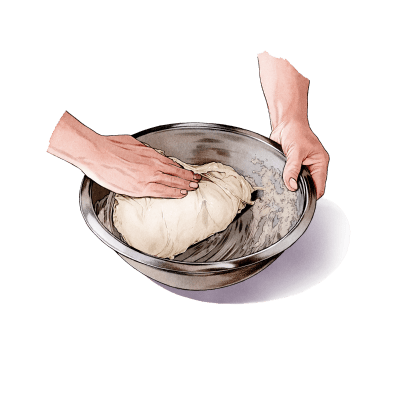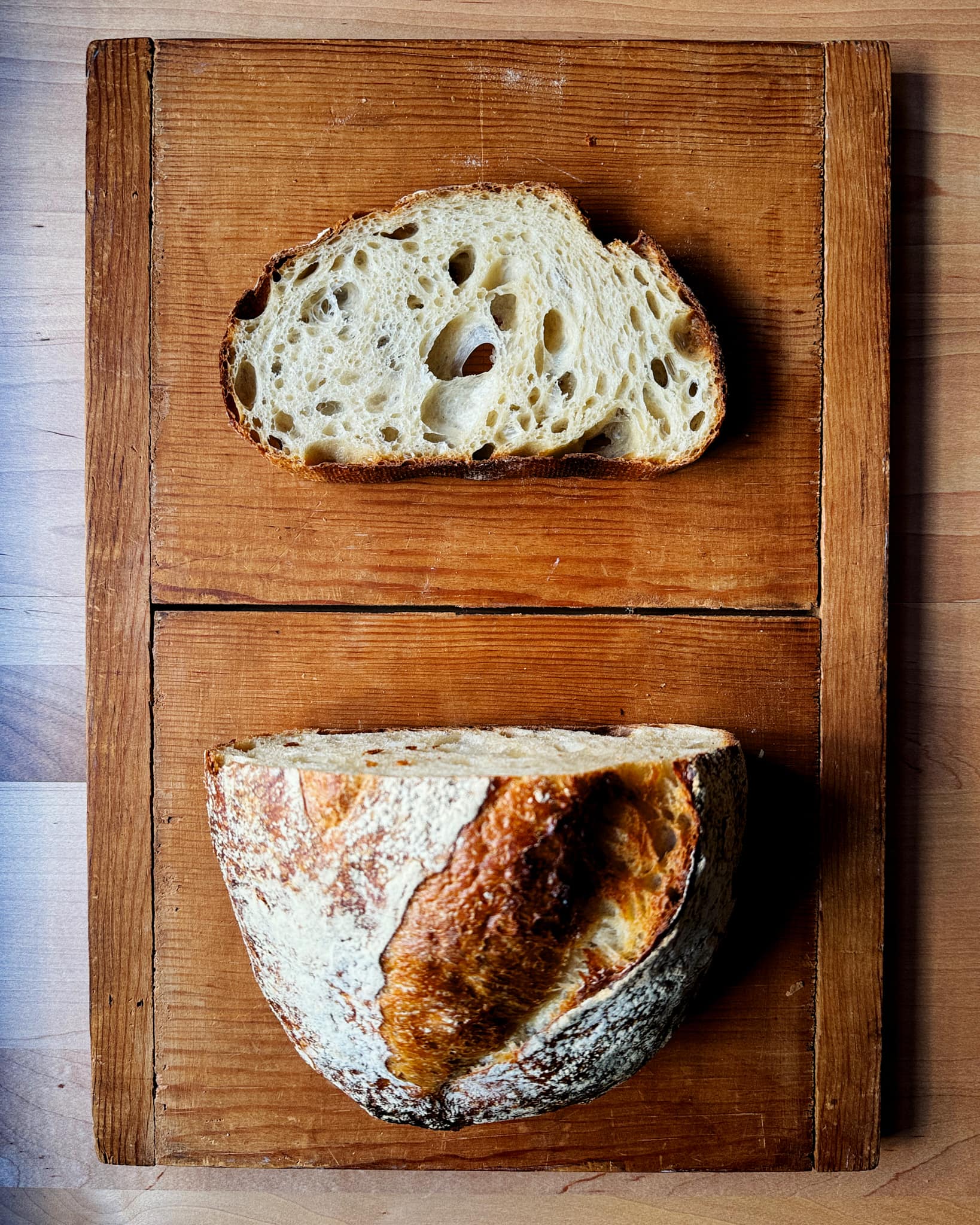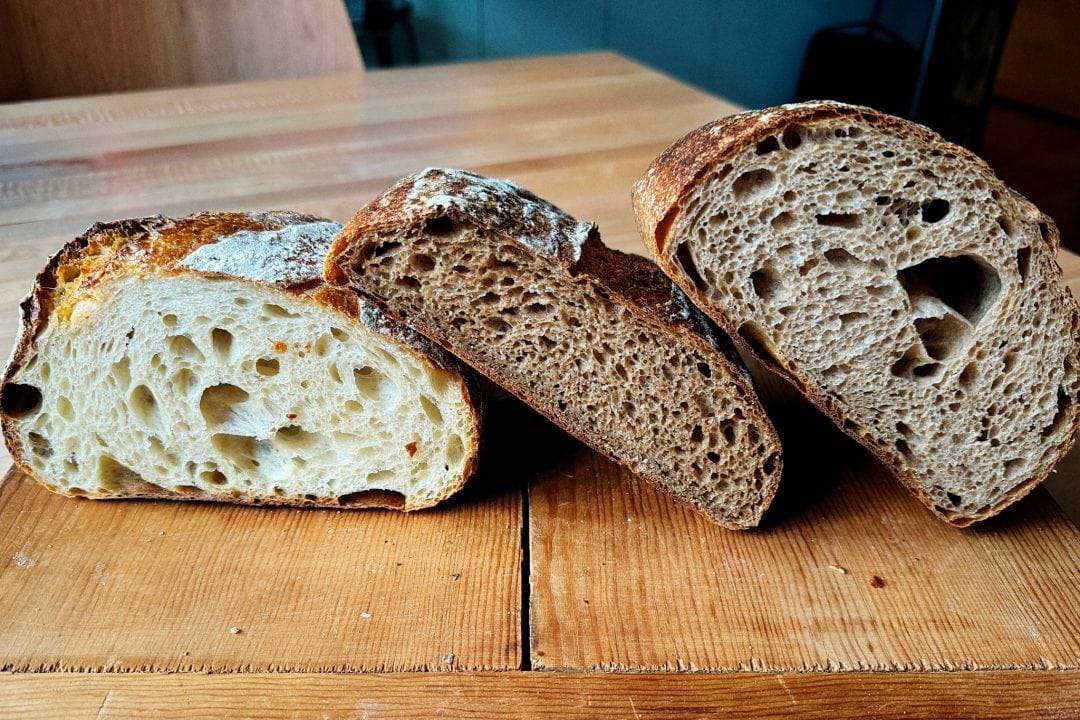Say you have two favorite, reliable bread recipes, one using white bread flour and the other entirely whole wheat flour. Each recipe has an “ideal” hydration (the ratio of flour and water in the dough): less water for the bread flour one and more for the thirstier whole wheat one. Now, say you wanted to make a new recipe using a combination of the two flours in equal proportions, for a dough that behaves more or less identically to the other two.
A simple, if slightly impractical, way to do this would be to just make two half batches of single-flour doughs separately, and then knead them together until they become a uniform, single dough. Such a combined “hybrid” dough will also have the ideal hydration for the new combination of flours and will make excellent bread, just like the two doughs it was made from. It will, of course, be fundamentally different from the originals because it now contains a mixture of two flours rather than one, but the amount of water it contains will nevertheless be “just right” for that new combination.
Once you have reliable single-flour formulas, you can calculate the ideal hydration of a novel formula by combining them on paper instead of in a mixing bowl.
You could also mix them together in different ratios—say 80% of the bread flour dough and 20% of the whole -wheat one in one batch, and 20% bread flour and 80% whole wheat in the other. Once again, the two resulting doughs will be different, but each will be hydrated exactly right since the doughs they started from were too.
No baker actually does this sort of thing in practice, but as a thought experiment, it illustrates how to precisely (and easily) determine the ideal hydration for a new dough from known ones. This last detail is key: You must know the ideal hydration for each of the individual flours for it to work.
Once you have reliable single-flour formulas, you can calculate the ideal hydration of a novel formula by combining them on paper instead of in a mixing bowl.
Let’s look at an example; but first, what is dough hydration?

What is Dough Hydration?
Dough hydration is simply the ratio of water to flour in a dough, represented by a percentage. If a formula includes a preferment—as does every sourdough—then the amount of flour and water in it must first be added to the flour and water in the final dough. (If a recipe includes a “total formula” table, the math has already been done for you.) Once you know the total amounts of flour and water in a formula, the hydration is determined by dividing the total weight of water by the total weight of flour, then multiplying the result by 100 to yield a percentage.

What is the Ideal Hydration for Bread Dough?
A bread dough’s “ideal” hydration means a ratio of flour and water known to work for a particular style of dough using that flour. Every flour has an ideal hydration range, meaning a range within which you get a workable dough and a good loaf of bread. Below this range, the dough will be too stiff to make bread, and above it, soup.
Maybe you’ll determine these numbers on your own through experimentation, or maybe you’ll start with formulas from someone else (say, those here at The Perfect Loaf). Exactly where a baker lands within the ideal hydration range for their dough and bread depends on what they are going for (extra extensibility, a dough that is easier to handle, a more tender crumb, etc.)—one person’s ideal hydration for a particular flour might well be different from another’s.
An Example: Combining Two Doughs With Known Hydrations to Make a Third Dough, Ideally Hydrated
Before you venture into combining dough, you can do it first on paper with baker’s percentages. Let’s look at two simple bread recipes and then combine them into a new, ideally hydrated recipe.
Note that in the example below, we’re looking at the total formula for each, which includes the sourdough starter, flour, and water in the ingredient weights listed.
Dough One (100% High-Protein White Flour)

Ideal hydration: 73.0%
| Ingredient | Weight |
|---|---|
| High-protein white bread flour | 500g |
| Water | 365g |
Dough Two (100% Whole-Wheat Flour)

Ideal hydration: 90.0%
| Ingredient | Weight |
|---|---|
| Whole-wheat flour | 500g |
| Water | 450g |
Creating a New Dough From Dough One and Dough Two

Photo by Andrew Janjigian.

Photo by Andrew Janjigian.

Photo by Andrew Janjigian.
Now, when you combine the components of those two doughs together, you get this:
| Ingredient | Weight |
|---|---|
| Bread flour | 500g |
| Whole wheat flour | 500g |
| Water | 815g (365g + 450g) |
To calculate the hydration of a new combined hybrid dough, you add the weight of the flours together and then divide the weight of the water by that number:
815g water ÷ 1000g flour = 81.5% hydration
In other words, if the ideal hydration of your 100%-bread flour dough is 73% and the ideal hydration of your 100%-whole wheat dough is 90%, then the ideal hydration of a 50-50 mix of bread and whole wheat flours is going to be 81.5%, the average hydration of the two initial doughs.
Getting Simpler: Finding the Ideal Hydration Without Formulas
There is an even simpler way to determine the ideal hydration of a new dough, one that doesn’t require formulas at all: You just multiply the percentage of each flour in the new dough by its ideal hydration, then add the percentages together:
50% bread flour: 0.5 x 73% = 36.5%
50% whole wheat flour: 0.5 x 90% = 45%
36.5% + 45% = 81.5%
You can do this with any ratio of flours, not just a 50-50 mix. Say instead that you want to make a dough that is 80% bread flour and 20% whole wheat flour:
80% bread flour: 0.8 x 73% = 58.4%
20% whole wheat flour: 0.2 x 90% = 18%
58.4% + 18% = 76.4%
Or one that is 80% whole wheat flour and 20% bread flour:
80% whole wheat flour: 0.8 x 90% = 72%
20% bread flour: 0.2 x 73% = 14.6%
72% + 14.6% = 86.6%
Does This Work For More Than Two Types of Flour?
Yes, this even works for doughs containing three (or more) flours. Using the bread and whole wheat flours from above, say you also have a 100% whole-grain spelt formula with an ideal hydration of 84%. Next, you want to create a formula that is 70% bread flour, 15% whole wheat, and 15% spelt:
70% bread flour: 0.7 x 73% = 51.1%
15% whole wheat flour: 0.15 x 90% = 13.5%
15% spelt flour: 0.15 x 84% = 12.6%
51.1% + 13.5% + 12.6% = 77.2%
I hope this clarifies how useful this concept is for formula creation. It’s one big reason I personally focus heavily on perfecting single-flour formulas—they might be simple, but they make a reliable jumping-off point for infinite numbers of more complex variations. Once you have a tried-and-true collection of basic formulas, there is no limit to the number of novel ones you can easily make using this approach.
What’s Next?
Now that you know how to calculate the ideal hydration for a new dough based on two previously known ones, a good place to try it out is with a tried-and-true sourdough recipe with all-purpose flour and an all-whole wheat recipe.




